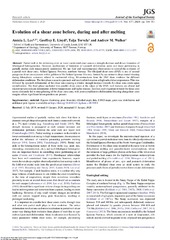Blar i forfatter "Lee, Amicia"
-
Biogeochemistry and timing of methane-derived carbonate formation at Leirdjupet fault complex, SW Barents sea
Argentino, Claudio; Lee, Amicia; Fallati, Luca; Sahy, Diana; Birgel, Daniel; Peckmann, Jörn; Bünz, Stefan; Panieri, Giuliana (Journal article; Tidsskriftartikkel; Peer reviewed, 2022-10-25)The origin of modern seafloor methane emissions in the Barents Sea is tightly connected to the glacio-tectonic and oceanographic transformations following the last ice age. Those regional events induced geological structure re-activation and destabilization of gas hydrate reservoirs over large areas of the European continental margins, sustaining widespread fluid plumbing systems. Despite the ... -
Deformation Behavior and Inferred Seismic Properties of Tonalitic Migmatites at the Time of Pre‐melting, Partial Melting, and Post‐Solidification
Shao, Yilun; Piazolo, Sandra; Liu, Yongjiang; Lee, Amicia; Jin, Wei; Li, Weimin; Liang, Chenyue; Wen, Quanbo (Journal article; Tidsskriftartikkel, 2021-01-21)As seismic data from the lower crust becomes more readily available, it is important to link seismic properties to the ongoing processes within lower crustal evolution. This includes high temperature, pre‐ and post‐migmatization solid state deformation as well as melt‐present deformation. We selected two tonalitic migmatites with variable former melt content (one metatexite and one diatexite) from ... -
Dissolution precipitation creep as a process for the strain localisation in mafic rocks
Lee, Amicia; Stunitz, Holger; Soret, Mathieu; Battisti, Matheus Ariel (Journal article; Tidsskriftartikkel; Peer reviewed, 2022-01-01)The lower crust is, on average, mafic in composition and composed of minerals that remain mechanically strong up to high temperatures. Here we show that dissolution-precipitation creep (as a type of diffusion creep) plays a major role in deformation of gabbro bodies at upper amphibolite facies conditions. The Kågen gabbro, N. Norway, is comprised of undeformed gabbro lenses enclosed by mylonitised ... -
Effect of pressure on the deformation of quartz aggregates in the presence of H2O
Nègre, Lucille; Stunitz, Holger; Raimbourg, Hugues; Lee, Amicia; Précigout, Jacques; Pongrac, Petar; Jeřábek, Petr (Journal article; Tidsskriftartikkel; Peer reviewed, 2021-04-17)Quartzite samples of high purity with a grain size of ~200 μm have been experimentally deformed by coaxial shortening in a solid medium apparatus at 900 °C and at confining pressures ranging from 0.6 to 2 GPa. Most samples have been shortened by ~30% with 0.1 wt% added H<sub>2</sub>O. The samples deformed dominantly by crystal plasticity (dislocation creep), and there is a systematic decrease of ... -
Evidence of Arctic methane emissions across the mid-Pleistocene
Panieri, Giuliana; Knies, Jochen Manfred; Vadakkepuliyambatta, Sunil; Lee, Amicia; Schubert, Carsten J. (Journal article; Tidsskriftartikkel; Peer reviewed, 2023-04-08)During the Pleistocene, Earth’s climate changed dramatically. The mid-Pleistocene transition (MPT; ~1.3–0.7 million years (Ma)) featured an important ice volume increase at both poles. The evolution of large Arctic ice sheets caused the sequestration of methane as free gas and hydrates in subseabed sediments. Ice volume changes, associated with variable pressures and temperatures, perturbed those ... -
Evolution of a shear zone before, during and after melting
Lee, Amicia; Lloyd, Geoffrey E.; Torvela, Taija; Walker, Andrew M. (Journal article; Tidsskriftartikkel; Peer reviewed, 2020-03-03)Partial melt in the deforming mid- or lower continental crust causes a strength decrease and drives formation of lithological heterogeneities. However, mechanisms of formation of syn-melt deformation zones and strain partitioning in partially molten rock remain poorly understood. We use field and microstructural observations to unravel the evolution of a partial melt shear zone, Seiland Igneous ... -
A practical method to determine the five-parameter orientation of intragranular boundaries in polycrystals
Lloyd, Geoffrey E.; Lee, Amicia; Kahl, Maren (Journal article; Tidsskriftartikkel; Peer reviewed, 2021-06-04)Intragranular boundaries are important features of polycrystalline materials and impact on many physical and chemical properties. Knowledge of their physical orientation is often crucial to explain such properties. However, it has proved difficult to determine the complete orientation of intragranular boundaries, which involves the misorientation angle and axis about which the adjacent crystal ... -
TitaniQ temperatures and textural analysis as a record of the deformation history in a major continental shear zone system, Borborema Province, Brazil
Cavalcante, Carolina; de Jesus Costa, Juliana; Lagoeiro, Leonardo; Fossen, Haakon; Lee, Amicia; Archanjo, Carlos; Vizeu, Roberto (Journal article; Tidsskriftartikkel; Peer reviewed, 2022-09-01)We combine quartz textural analysis with Titanium-in-quartz (TitaniQ) geothermometry to investigate the late stages of deformation in mylonitic rocks from the Sucuru dike swarm in the Borborema Province. The wide range in TitaniQ temperatures (>340 to 740 °C) closely related to grain sizes are attributed to inefficient Ti resetting during bulging (BLG) and subgrain rotation (SGR) recrystallization. ...


 English
English norsk
norsk






